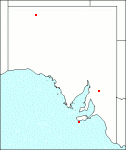Family: Asteraceae
Helichrysum apiculatum
Citation:
D. Don, Mere. Werner Nat. Hist. Soc. 5:550 (1824).
Synonymy: Gnaphalium apiculatum Labill., Nov. Holl. Pl. Sp. 2:43 (1806); H. ramosissimum Hook. in T.L. Mitchell, J. Trop. Austral. 83 (1848); H. apiculatum (Labill.) D. Don var. minor Benth., Fl. Aust. 3:625 (1867); H. apiculatum (Labill.) D. Don var. occidentale Benth., Fl. Aust. 3:625 ( 1867); H. apiculatum (Labill.) D. Don var. racemosum J. Black, Fl.S. Aust. 633 (1929).
Common name: Common everlasting, yellow buttons.
Description:
Very variable sometimes bushy perennial herb 7-60 cm tall with a woody rootstock; stems and branches with a densely matted to rather loose vestiture of woolly-cobwebby hairs (rarely absent), with underlying septate glandular hairs; leaves linear-lanceolate to oblanceolate or spathulate, flat or with recurved margins, with an acuminate to rounded but always apiculate apex and a broadly sessile to stem-clasping base, 1-6 cm long, 1-25 mm broad, with vestiture as on the stems, sometimes slightly denser below.
Capitula several to numerous in compact corymbose, paniculate or racemose clusters terminating lateral and terminal leafy to distally almost leafless branches and stems, sessile or shortly pedunculate, campanulate to obconical, 5-8 mm long, 7-15 mm diam.; involucral bracts c. 10-seriate, the intermediate ones longest; outer bracts wholly scarious, more or less opaque, golden-yellow or lightly to strongly tinged-brown (occasionally white when sometimes tinged pink), ovate to lanceolate, acuminate, more or less entire towards the apex, ciliate in the lower half and partly enveloped in long woolly-cobwebby hairs; intermediate bracts about equal to the florets, with erect laminae similar to the outer bracts and with claws about equal in length to the laminae.
Achenes narrowly oblong-ovoid, more or less 4-angled, slightly compressed, glabrous or papillose; pappus bristles very finely barbellate and white in the lower half, bright-yellow and subplumose in the upper half, of bisexual florets 6-12, of female florets 3-8.
Published illustration:
Cunningham et al. (1982) Plants of western New South Wales, p. 701 .
|
|
Distribution:
|
A widespread common species occurring in many varied situations but usually on open sites; in some areas infrequent except on disturbed sites such as roadsides.
All States.
|
Conservation status:
native
Flowering time: much of the year but especially Aug. — Nov.
|

SA Distribution Map based
on current data relating to
specimens held in the
State Herbarium of South Australia
|
Biology:
As described here, H. apiculatum is a polymorphic assemblage within which several variants almost certainly each deserving species rank can be recognised. However, although the extremes are clearly defined, further study on an Australia-wide basis is required to determine the nature of apparent intermediates and the application of names, of which there are many to be accounted for in the literature.
Taxonomic notes:
The H. apiculatum complex is very close to the H. semipapposum group and apparent intermediates yet to be adequately assessed, occur.
Author:
Not yet available
|

